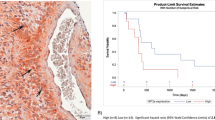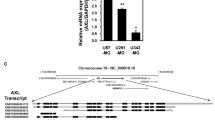Abstract
Hypoxia is a common feature of many malignant neoplasms and has been identified as a major reason for the radioresistance of malignant tumor tissue. On the other hand, the transcription factor hypoxia-inducible factor-1 (HIF-1) has attracted attention because it is rapidly expressed when tissue oxygen tension is reduced, thus playing the role of a hypoxic sensor. We investigated whether the level of HIF-1 expression in glioblastoma (GBM) could be an indicator in a protocol for postoperative radiotherapy. We immunohistologically evaluated the level of HIF-1 expression in 60 pathologically diagnosed GBMs. HIF-1 expression was positive in all tumors. The progression-free survival of the group receiving only conventional radiotherapy after surgery differed significantly according to the level of HIF-1 expression. The results of this study suggest that the HIF-1 expression level can be an indicator of tumor radioresistance, and that prior knowledge of the HIF-1 expression level allows the formulation of a protocol for post-operative radiotherapy.
Similar content being viewed by others
References
Semenza GL (2000) HIF-1 and human disease: one highly involved factor. Genes Dev 15:1983–1991
Salceda S, Caro J (1997) Hypoxia-inducible factor 1α (HIF-1α) protein is rapidly degraded by the ubiquitin-proteasome system under normoxic conditions. J Biol Chem 272:22642–22647
Wang GL, Jiang B-H, Rue EA, et al (1995) Hypoxia-inducible factor 1 is a basic-helix-loop-helix-PAS heterodimer regulated by cellular O2 tension. Proc Natl Acad Sci USA 92:5510–5514
Burri P, Djonov V, Aebersold DM, et al (2003) Significant correlation of hypoxia-inducible factor-1α with treatment outcome in cervical cancer treated with radical radiotherapy. Int J Radiat Oncol Biol Phys 55:1239–1246
Semenza GL (2000) HIF-1: mediator of physiological and pathophysiological responses to hypoxia. J Appl Physiol 88:1474–1480
Maxwell PH, Dachs GU, Gleadle JM, et al (1997) Hypoxia-inducible factor-1 modulates gene expression in solid tumors and influences both angiogenesis and tumor growth. Proc Natl Acad Sci USA 94:8104–8109
Lutterbach J, Sauerbrei W, Guttenberger R, et al (2003) Multivariate analysis of prognostic factors in patients with glioblastoma. Strahlenther Onkol 179:8–15
Aebersold DM, Burri P, Beer KT, et al (2001) Expression of hypoxia-inducible factor-1α: a novel predictive and prognostic parameter in the radiotherapy of oropharyngeal cancer. Cancer Res 61:2911–2916
Birner P, Schindl M, Obermair A, et al (2001) Expression of hypoxia-inducible factor 1α in epithelial ovarian tumors: its impact on prognosis and on response to chemotherapy. Clin Cancer Res 7:1661–1668
Birner P, Schindl M, Obermair A, et al (2000) Overexpression of hypoxia-inducible factor 1α is a marker for an unfavorable prognosis in early-stage invasive cervical cancer. Cancer Res 60:4693–4696
Zagzag D, Zhong H, Scalzitti JM, et al (2000) Expression of hypoxia-inducible factor 1α in brain tumors: association with angiogenesis, invasion, and progression. Cancer 88:2606–2618
Ryan HE, Poloni M, McNulty W, et al (2000) Hypoxia-inducible factor-1α is a positive factor in solid tumor growth. Cancer Res 60:4010–1015
Talks KL, Turley H, Gatter KC, et al (2000) The expression and distribution of the hypoxia-inducible factors HIF-1α and HIF-2α in normal human tissues, cancers, and tumor-associated macrophages. Am J Pathol 157:411–421
Horsman MR (1998) Measurement of tumor oxygenation. Int J Radiat Oncol Biol Phys 42:701–704
Lyng H, Sundfor K, Rofstad EK (1997) Oxygen tension in human tumours measured with polarographic needle electrodes and its relationship to vascular density, necrosis and hypoxia. Radiother Oncol 44:163–169
Haugland HK, Vukovic V, Pintilie M, et al (2002) Expression of hypoxia-inducible factor-1α in cervical carcinomas: correlation with tumor oxygenation. Int J Radiat Oncol Biol Phys 53:854–861
Doll CM, Milosevic M, Pintilie M, et al (2003) Estimating hypoxic status in human tumors: a simulation using Eppendorf oxygen probe data in cervical cancer patients. Int J Radiat Oncol Biol Phys 55:1239–1246
Becker A, Kuhnt T, Liedtke H, et al (2002) Oxygenation measurements in head and neck cancers during hyperbaric oxygenation. Strahlenther Onkol 178:105–108
Nordsmark M, Overgaard M, Overgaard J (1996) Pretreatment oxygenation predicts radiation response in advanced squamous cell carcinoma of the head and neck. Radiother Oncol 41:31–39
Zhong H, Agani F, Baccala AA, et al (1998) Increased expression of hypoxia inducible factor-1α in rat and human prostate cancer. Cancer Res 58:5280–5284
Cvetkovic D, Movsas B, Dicker AP, et al (2001) Increased hypoxia correlates with increased expression of the angiogenesis marker vascular endothelial growth factor in human prostate cancer. Urology 57:821–825
Kayama T, Yoshimoto T, Fujimoto S, et al (1991) Intratumoral oxygen pressure in malignant brain tumor. J Neurosurg 74:55–59
Beppu T, Kamada K, Yoshida Y, et al (2002) Change of oxygen pressure in glioblastoma tissue under various conditions. J Neuro-Oncol 58:47–52
Cruickshank GS, Rampling R (1994) Peri-tumoural hypoxia in human brain: peroperative measurement of the tissue oxygen tension around malignant brain tumours. Acta Neurochir Suppl (Wien) 60:375–377
Collingridge DR, Piepmeier JM, Rockwell S, et al (1999) Polarographic measurements of oxygen tension in human glioma and surrounding peritumoural brain tissue. Radiother Oncol 53:127–131
Acker T, Plate KH (2002) A role for hypoxia and hypoxia-inducible transcription factors in tumor physiology J Mol Med 80:562-f575
Semenza GL (2000) Expression of hypoxia-inducible factor 1: mechanisms and consequences. Biochem Pharmacol 59:47–53
Bickler PE, Donohoe PH (2002) Adaptive responses of vertebrate neurons to hypoxia. J Exp Biol 205:3579–3586
Oehring RD, Miletic M, Valter MM, et al (1999) Vascular endothelial growth factor (VEGF) in astrocytic gliomas—a prognostic factor? J Neuro-Oncol 45:117–125
Kuwai T, Kitadai Y, Tanaka S, et al (2003) Expression of hypoxia-inducible factor-1α is associated with tumor vascularization in human colorectal carcinoma. Int J Cancer 105:167–181
Zhong H, De Marzo AM, Laugher E, et al (1999) Overexpression of hypoxia-inducible factor 1α in common human cancers and their metastases. Cancer Res 59:5830–5835
Sondergaard KL, Hilton DA, Penney M, et al (2002) Expression of hypoxia-inducible factor 1α in tumours of patients with glioblastoma. Neuropathol Appl Neurobiol 28:210–217
Author information
Authors and Affiliations
Corresponding author
Rights and permissions
About this article
Cite this article
Irie, N., Matsuo, T. & Nagata, I. Protocol of radiotherapy for glioblastoma according to the expression of HIF-1. Brain Tumor Pathol 21, 1–6 (2004). https://doi.org/10.1007/BF02482169
Received:
Accepted:
Issue Date:
DOI: https://doi.org/10.1007/BF02482169




